FUTURE OF FLIGHT • March 2021
The world’s coolest air traffic control towers
The totemic watchtowers that control the ebb and flow of airplane traffic in and around airports are also icons of architectural style and ingenuity. Aero-industry journalist Paul Sillers checks out some of the most inspiring air traffic control tower designs…
Last year was the centenary of the world’s first control tower in what was once London’s main air hub, Croydon Airport. The remit for controllers in the 1920s was to provide traffic, location and weather information to pilots via radio to support a dozen or so daily flights, which were plotted on paper maps using pins and flags.
A hundred years on, the tech has advanced significantly, of course – paper maps and pins have become superseded by real-time satellite tracking to enhance safety and environmental performance of flights. And soon artificial intelligence will be used to cut weather-related delays.
The visible part of an air traffic control tower, the glass-clad turret, houses the visual control room (VCR), which handles air traffic within eight miles of the airport. Perched above the hubbub, in a typical scenario there will be a team of six controllers attending to ground movements, landings and take-offs. But there’s a whole lot more that goes on, in and around the tower, that’s out of sight.
Working together with the VCR is the approach control room (ACR), where another cohort of controllers manage aircraft once they’re within 30 miles of the airport. The ACR team handles aircraft in the holding stacks and agrees spacing and sequencing of each aircraft’s final approach. And underpinning this hive of activity is the main equipment room, which keeps the communications, weather, data, surveillance and navigation gear in tip-top condition.
Air traffic control towers are not only functional linchpins at airports. They’re also prized by architects as showcases of innovative design. Here’s a handful of next-level (geddit?) examples...
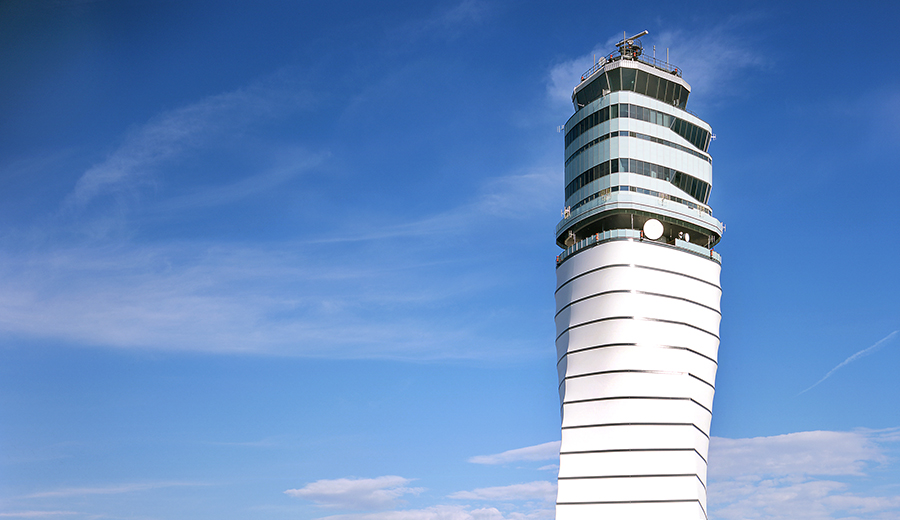
Vienna’s Schwechat Airport
Vienna Airport’s ATC tower (pictured) is designed, says its architect Zechner & Zechner, “to be to Vienna airport what a lighthouse is to its surrounding area.” And at over 108m, the tower is visible from far, far away, acting as an orientation point for arriving passengers. To facilitate the lighthouse concept, the external shell of the building incorporates a membrane that is externally illuminated from three different directions by means of high-definition digital projectors. This is coupled with backlighting effects provided by lamps attached to the tower shaft. A computer programme enables varying lighting moods to be generated.
The building, which integrates both the control tower and the air traffic control centre, is also unconventional in having a turret that is twisted 45° from the base to enable controllers to obtain the best possible view of the airfield.
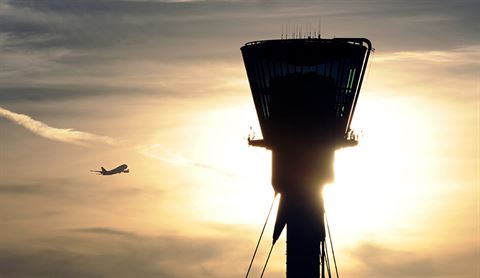
London Heathrow
When Rogers Stirk Harbour + Partners (architects of British Airways’ LHR Terminal 5) designed Heathrow Airport’s tower (pictured), the goal was “to create an elegant and memorable building that would be a symbol of the ongoing development of Heathrow without dominating the skyline.”
“Compared by the philosopher Alain de Botton to a work by Brunel, the Heathrow Air Traffic Control Tower represents the very best of British engineering,” says Stephen Barrett, project partner, Rogers Stirk Harbour + Partners. “Designed to be as discreet as possible on the skyline, an extremely slender steel mast supports the largest visual control room of any control tower in the world, providing an unobstructed 360° cone of vision of the whole Heathrow airfield – the views take your breath away.”
Barrett says that the principle applied “was that of a ‘fishing float’ – almost invisible but for a dash of bright colour, which explains the red zone at the base of the top of the tower. Otherwise, the colour scheme was predicated on blending into the sky as much as possible.”
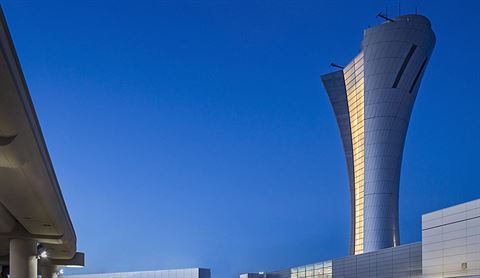
San Francisco International Airport
Due to its location four miles from the San Andreas Fault, San Francisco International Airport air traffic control tower (pictured) is designed to withstand a magnitude 8.0 earthquake. Designed by Fentress Architects in association with HNTB, the soaring 67m-tall facility features a vertical post-tension system that prevents the tower from swaying with high wind loads and has a ‘self-centring’ capability in the event of an earthquake.
The geometrically complex tower features a twisting façade which, says Fentress Architects, “resembles a torch, hearkening back to a time in the city’s history when torches were used to guide ships into dock.”
The west face of the tower features a backlit glass façade that acts as a beacon – guiding both airplanes and passengers to the airport. Its multiple glass-fronted panels, illuminated by colour-changing and programmable light-emitting diodes, transform the tower in recognition of holidays and special events. Integrated facilities in the project include an FAA office building, a courtyard and a green roof, providing outdoor space where air traffic controllers can rest between shifts.
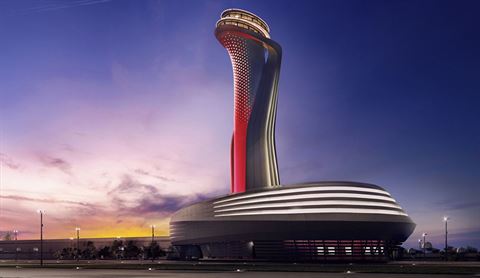
The new Istanbul Airport
Pininfarina is a design consultancy mostly associated with Ferrari and Alfa Romeo. So it’s hardly surprising that when it teamed up with AECOM’s architectural and engineering experts to design the ATC tower (pictured) for Istanbul’s new airport, the outcome was destined to look anything but static.
“Our aim was to combine the dynamism and romance of Pininfarina’s architectural style that is so influenced by automotive design with AECOM’s in-house aviation architecture capabilities,” says Jennifer Dixon, head of architecture, Europe, Middle East, India and Africa, AECOM.
The result? The elliptical tower evokes the aerodynamic contours of both the automotive and aviation worlds, and is inspired by the tulip, a symbol of Istanbul for centuries and an important cultural reference in Turkish history.
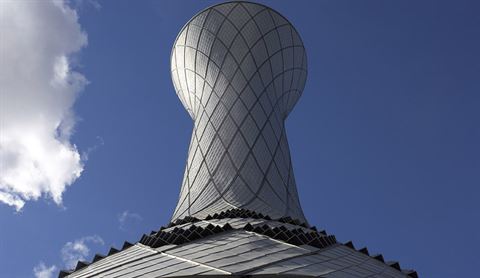
Edinburgh Airport
British architect 3DReid created an ATC tower (pictured) for Edinburgh Airport that melds the tower and base, forming an integrated structure that accommodates 50 NATS air traffic controllers, ATC assistants, engineers and support staff. It’s an architectural configuration that locates all technical equipment at the base, freeing up the observation spaces for movement and sightlines. The tower, which can be seen across Edinburgh and the Lothians, features drainage channels arranged in a double helix pattern across the face of the tower cladding, adding functionality to the design as well as giving it a distinctive look.
The design incorporates a number of environmentally friendly features, and functions symbiotically with nature: For example, the cladding is made from 9,216 zinc shingle tiles which age naturally and reduce the need for maintenance, and the floors are designed with a ring of continuous glazing integrated into the façade, allowing natural light in. Additionally, the floors containing plant equipment have integrated slatted vents to keep the equipment naturally ventilated.
This article has been tagged Destination, Technology
More from previous issues

The best of British Airways news
All the latest and greatest from BA, including BrewDog and a new coworking space at Twickenham Stadium

Which Covid-19 test is right for you?
The new normal: you need proof of a negative test for your next trip, but where to start? We find the BA-approved test to suit your lifestyle

How do you… design a menu at 35,000 feet?
Michelin-starred chef and TV presenter Tom Kerridge tells us the story behind his inspired new menu for British Airways

Where is the most romantic city break on earth?
Paris vs Istanbul. Two writers passionately plead their cases for where to go when love is in the air. Swoon!
